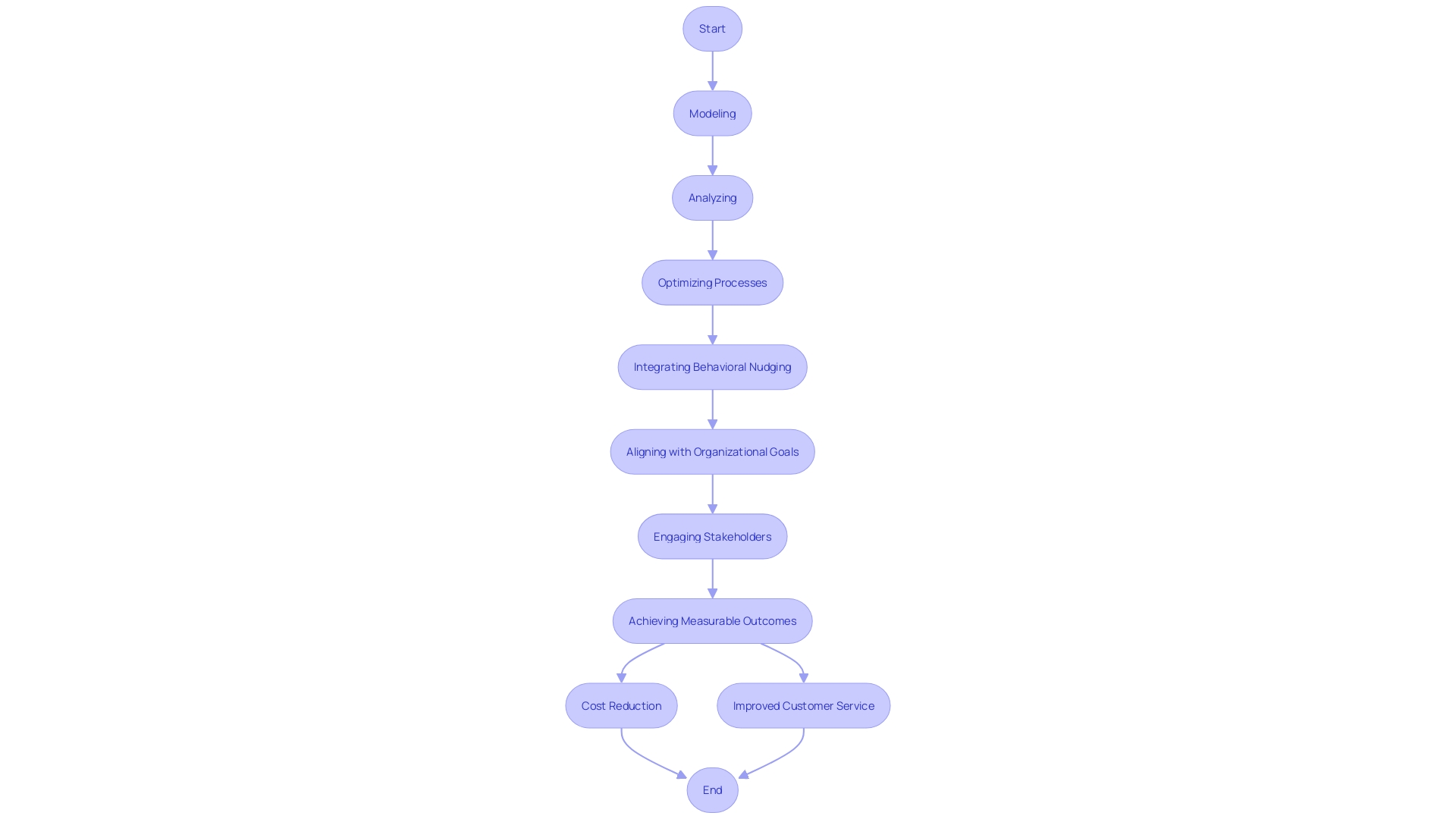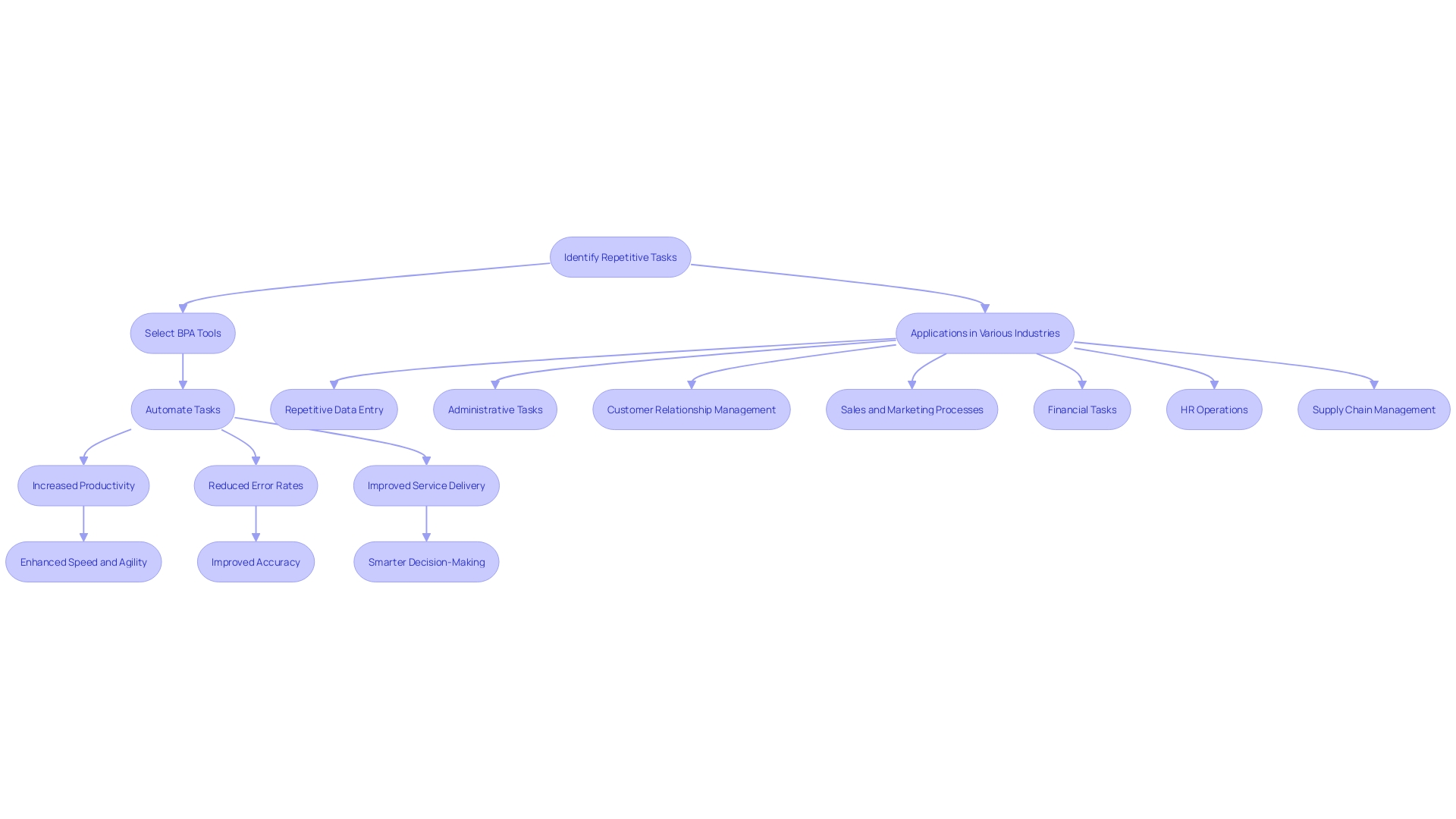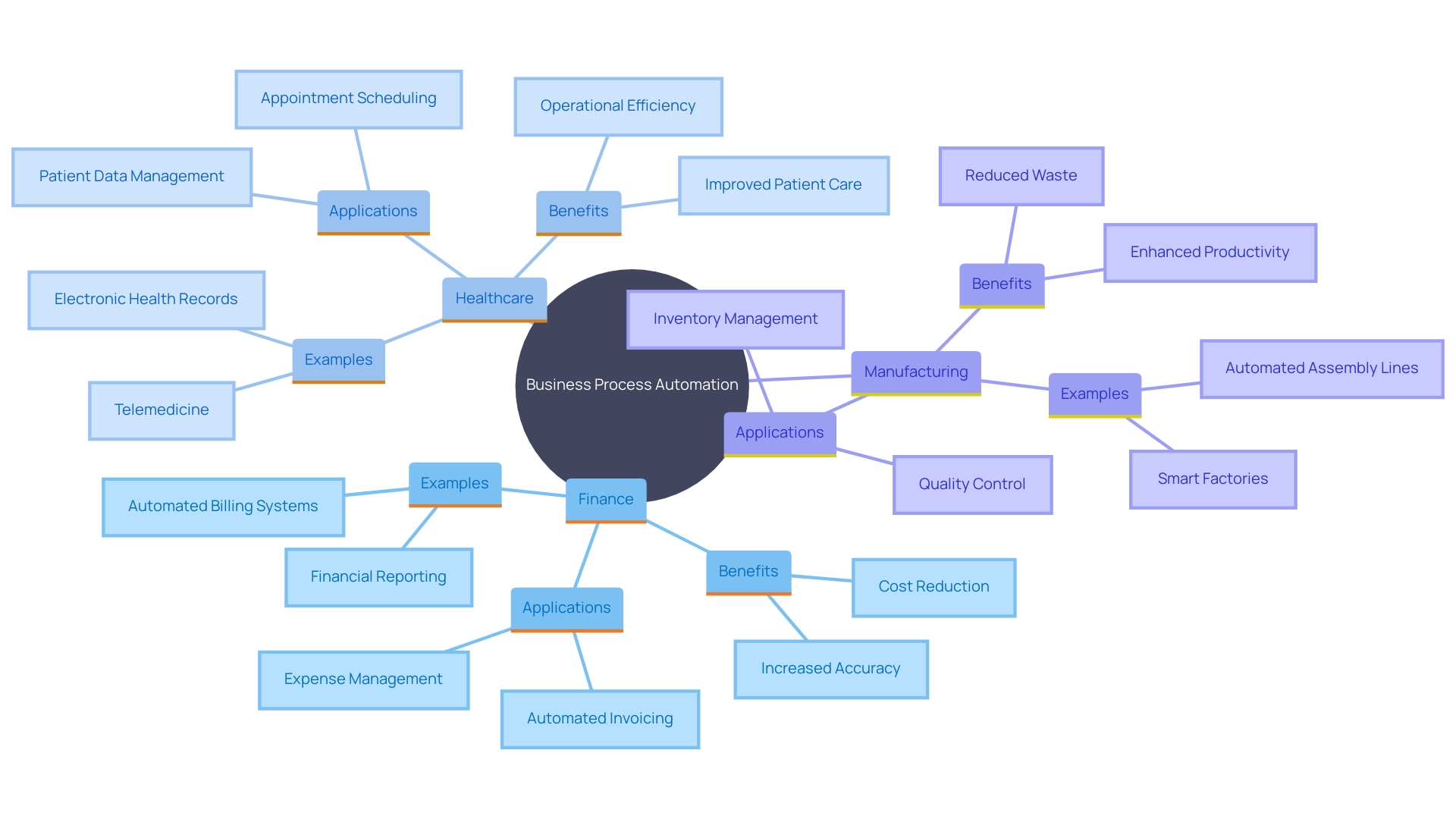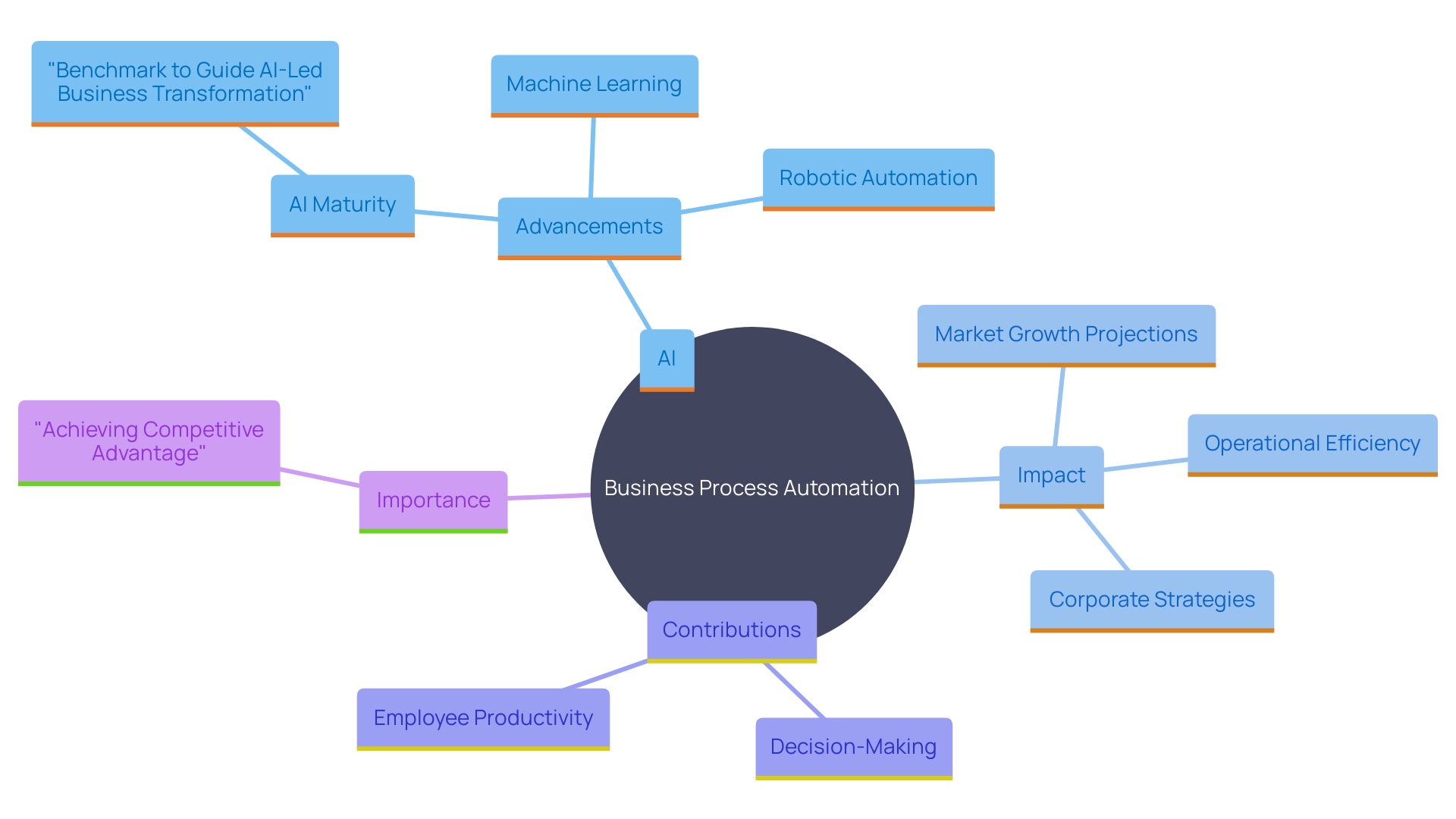Introduction
In the ever-evolving landscape of business operations, the pursuit of efficiency and effectiveness is paramount. Business Process Management (BPM) and Business Process Automation (BPA) emerge as critical strategies for organizations aiming to streamline workflows, reduce errors, and enhance productivity. This article delves into the intricacies of BPM and BPA, highlighting their definitions, benefits, practical applications, and future potential.
By exploring real-world examples and industry insights, it offers valuable guidance for directors of operations efficiency seeking to implement these powerful tools. Embracing BPM and BPA not only fosters continuous improvement but also equips organizations to adapt swiftly to market changes, ensuring sustained growth and a competitive edge.
What is Business Process Management (BPM)?
Business Process Management (BPM) is a strategic approach to enhancing an organization’s workflows by leveraging various methodologies and tools. It involves modeling, analyzing, and optimizing existing processes to boost efficiency and effectiveness. BPM aligns operational processes with organizational objectives, fostering continuous improvement and adaptability to market changes. For instance, TBC Bank’s agile transformation aimed at reducing organizational complexity and enhancing operational speed highlights the critical role of BPM in achieving company growth. BPM software, like Jira Work Management, simplifies and automates tasks, thus enhancing productivity and effectiveness. By engaging stakeholders early and setting clear objectives, organizations can achieve measurable outcomes like cost reduction and improved customer service. The integration of behavioral nudging into BPM phases also offers a human-centric approach, making processes more sustainable and adaptable.

What is Business Process Automation (BPA)?
Business Process Automation (BPA) leverages technology to streamline and automate repetitive tasks within business workflows. This approach aims to improve productivity, minimize manual intervention, and significantly reduce error rates. By implementing BPA, organizations can boost productivity, accelerate operations, and optimize resource allocation, leading to superior service delivery and heightened customer satisfaction.
For instance, St. James Winery, a leading U.S. wine producer, turned to automation to manage increased growth and labor shortages. This strategic move not only improved production speeds but also enhanced their margins and overall effectiveness. The winery measures ROI in terms of labor per case, showcasing tangible benefits from automation.
BPA is particularly beneficial across various industries for automating processes like data entry, administrative tasks, customer relationship management, and supply chain management. The market for Industrial Automation Services is projected to grow from $147.06 billion in 2019 to $264.69 billion by 2026, reflecting the increasing adoption of automation technologies.
Moreover, statistics indicate that while automation can lead to job displacement, it also offers opportunities for improved job satisfaction and operational agility. For example, 69% of managerial work is expected to be automated by 2024, highlighting a shift towards more strategic roles for human workers.
‘Business Workflow Management (BPM) tools are essential to BPA, providing features like drag-and-drop builders, real-time analytics, and workflow automation.’. These tools not only improve effectiveness and productivity but also aid informed decision-making and cost reduction. As companies continue to evolve, adopting BPA becomes crucial for maintaining competitive advantage and meeting market demands effectively.

Benefits of Business Process Automation
Business Process Automation (BPA) offers an array of benefits that can transform operations. By automating routine tasks, BPA significantly enhances operational efficiency, leading to faster service delivery. A key advantage is the reduction of human errors, which ensures higher quality outcomes. For instance, St. James Winery, a leading wine producer in the U.S., has seen higher production speeds and better margins through automation, realizing ROI in terms of labor per case.
Moreover, BPA allows employees to redirect their efforts towards more strategic initiatives, fostering innovation and creativity within the organization. This change not only improves employee satisfaction but also fuels company growth. Automation technology allows companies to scale operations efficiently, managing more transactions swiftly and enhancing competitiveness.
Cost savings are another major advantage. Automating processes can lower labor costs and reduce wasted resources. A study highlighted that small businesses could significantly reduce operational costs by automating repetitive, time-consuming tasks. Furthermore, efficient data processing methods such as batch and real-time processing maximize the benefits of automation, providing timely access to crucial information for decision-making.
As highlighted by specialists, “Executing tactics, clarifying misunderstandings, and acquiring a deeper insight into the benefits are crucial to unlocking all the possibilities in intelligent automation.” Business Workflow Automation is not merely about productivity; it represents a strategic method for attaining digital transformation and maintaining an edge in a competitive landscape.
Practical Applications of BPA
Business Process Automation (BPA) is transforming various sectors such as finance, healthcare, manufacturing, and customer service by automating repetitive and time-consuming tasks. In finance, for instance, BPA is pivotal in invoice processing and compliance reporting. A leading financial institution leveraged advanced fraud detection algorithms to identify suspicious transactions, significantly reducing fraudulent activities and bolstering customer trust.
In healthcare, BPA enhances patient care through automated scheduling and efficient record management. A healthcare organization implemented predictive analytics to forecast patient admission rates, optimize resource allocation, and ultimately improve patient outcomes. This resulted in lowered operational expenses and increased overall effectiveness in healthcare delivery.
Manufacturing also reaps substantial benefits from BPA. By automating inventory management and quality control, manufacturers can streamline workflows and reduce downtime. A manufacturing company adopted smart manufacturing capabilities to monitor machine performance, identify bottlenecks, and enhance productivity, resulting in increased profitability.
Each application of BPA demonstrates its potential to elevate operational efficiency and effectiveness, driving smarter decision-making and agility in today’s fast-paced business environment.

Future of Business Process Automation
‘The future of Business Automation (BPA) is increasingly bright, driven by advancements in artificial intelligence, machine learning, and robotic automation.’. These technologies are enabling organizations to automate more complex processes, offering greater scalability and flexibility. As Ludovic Doudard, General Manager Process Engineering Supply Chain at Renault, noted, the company’s AI tools development is expected to generate 45 million euros in digital value through 25 projects. This rapid deployment showcases how BPA can transform decision-making, amplifying precision and speed in organizational operations.
The Industrial Automation Services Market is projected to grow from $147.06 billion in 2019 to $264.69 billion by 2026. Such growth underscores the importance of BPA in achieving operational excellence and sustaining competitive advantage. As companies continue their digital transformation journeys, BPA will be pivotal. For instance, Renault’s use of AI to automate the extraction of key values from over 2,000 PDF documents has freed up employees for more meaningful work, demonstrating the real-world impact of BPA.
Furthermore, the trend toward digital and AI transformation is reshaping corporate strategies. Companies are increasingly recognizing that every worker is becoming a knowledge worker, and advanced AI capabilities are becoming integral to their roles. The capacity to utilize data efficiently is essential for creating operational value. As highlighted by industry leaders, a digital and AI transformation is a journey to continuously enhance competitiveness by quickly incorporating new technologies.
‘The ongoing shift in corporate strategies, as companies adapt to changing market dynamics, further illustrates the transformative power of BPA.’. By focusing on long-term metrics, objectives, and key results, organizations can ensure that their digital transformations have a lasting impact. This alignment of technology and business strategy is essential for maintaining a competitive edge in today’s rapidly evolving market landscape.

Conclusion
In summary, the integration of Business Process Management (BPM) and Business Process Automation (BPA) represents a strategic imperative for organizations striving for operational excellence. BPM serves as a foundational framework for identifying inefficiencies and aligning processes with broader business goals, while BPA complements this by automating repetitive tasks to enhance productivity and reduce error rates. Together, these methodologies empower organizations to streamline workflows, foster innovation, and ultimately drive growth.
The practical applications of BPM and BPA across various sectors underscore their transformative potential. From automating financial processes to improving patient care in healthcare, the benefits are clear: increased efficiency, reduced operational costs, and improved service delivery. As demonstrated by successful case studies, organizations that embrace these practices not only achieve immediate operational gains but also position themselves for long-term success in an increasingly competitive landscape.
Looking ahead, the future of BPA is bright, bolstered by advancements in technology such as artificial intelligence and machine learning. As businesses navigate digital transformation, the ability to automate complex processes will become essential for maintaining competitive advantage. By prioritizing BPM and BPA, organizations can ensure they remain agile, responsive, and well-equipped to meet the demands of an evolving market.
Embracing these strategies is not merely a choice; it is a necessity for any organization aiming to thrive in today’s dynamic business environment.

